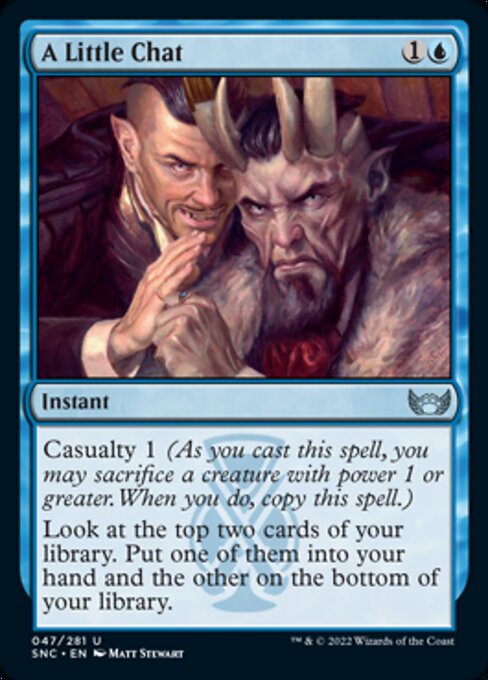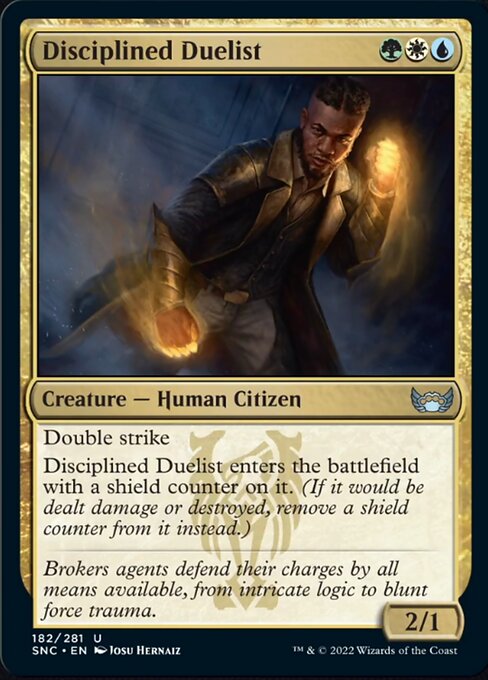Magic’s newest expansion has us journeying to the metropolis of New Capenna, a place built by angels but now fallen to the rule of five Demon-led crime families. A new set means new mechanics, and we’ve got a healthy dose of them as well as one returning one. In this article we’ll talk about the mechanics and offer some thoughts on what they mean for different formats and how they’ll play.

Alliance
Alliance is the primary mechanic of the Naya (RGW)-focused Cabaretti family, highlighting their close-knit family ties by triggering when other creatures enter the battlefield under your control.
FromTheShire: Someone get me a Corona because I’m here to join the family. I will never not enjoy a classic game of Magic as Richard Garfield intended, putting creatures into play and turning them sideways at my opponent, and anything rewards me for doing so rather than spellslinging combos is right up my alley. The fact that Alliance isn’t nontoken creature is excellent, and while the ability is very straightforward that’s part of the attraction.
BPhillipYork: Potentially a really powerful ability, it really depends on what exactly alliance is doing. Rumor Gatherer, for example, has “Alliance” scry 1, if this is the second time this ability has resolved this turn, draw a card instead. Well, that’s respectable card selection and card draw (for white, even). So I think it’s a fun mechanic, the creatures that have it cost 2-4 so it’s not something you can really “spam out” early, but it definitely could trigger a lot if you can say, for example, create a lot of tokens really rapidly.
TheChirurgeon: I mean generating a crapload of creature tokens – or just getting creatures going in and out of the battlefield a lot – is one of the game’s easier challenges, which makes this a cool ability to build around.

Blitz
Blitz is found in the Jund (BGR) focused Riveteer family, exemplifying their scrappy philosophy by letting you cast creatures for a cheaper alternate cost in order to give them haste, though they must then be sacrificed at the end of the turn.
FromTheShire: Dropping hasty creatures is incredibly good because it gives your opponent a much smaller window to deal with your threats, as well as denying them crucial information until the last possible moment. Jund has always been about value and there’s no part of a haste threat that draws a card when it dies that I don’t love, especially since in the colors there are an absolute ton of ways to synergize with creatures dying and having creatures in your graveyard. In Commander, you can even end your turn with something like Sundial of the Infinite to keep the creature around for maximum value.
BPhillipYork: So this mechanic to me is really powerful potentially. The delayed trigger making the creature die can be avoided if you can end your turn when you hit your end phase, it also means you can sacrifice the creature for something else and get double value, which is something that Black, Red, and Green are all great at. I think this is potentially one of the more powerful mechanics New Cappena showcases.
TheChirurgeon: I really like the replacement aspect of this new take on Dash. Putting something in your graveyard and drawing another card is a solid tradeoff, and makes throwing a Dash creature at your opponent as a more interesting way to cycle a card in stalled boardstates something I’d consider.

Casualty
Casualty represents the Grixis (UBR) Maestro family and their cutthroat nature, allowing you to sacrifice creatures to copy the spell you are casting.
FromTheShire: This is an ability that absolutely has the potential to do busted things, but Wizards seems to have done a good job of acknowledging that and reigning the design in. Lots of decks end up making tokens somewhat incidentally, or have tokens that become less useful as the game goes long, and having a use for say your Decayed Zombie token is a definite plus.
BPhillipYork: Doubling spells for a sacrifice is again really powerful (okay copying not doubling, yes, I know what magecraft is). The really powerful thing would be giving casualty to other spells that don’t have it, if they do that…
TheChirurgeon: They seem to have been pretty cautious with what they let you copy using Casualty. Which is kind of disappointing?

Connive
The aptly named Connive is used by the Esper (WUB) Obscura family, famed for their manipulations and distractions. This allows you to draw and then discard a card to help you get into the position you want, while also allowing you to grow your creatures if you discard a nonland card.
BPhillipYork: As far as I can tell connive is looting with an added bonus, but for some reason, it was given to White, Blue, and Black, which are both of Red’s opposites on the color wheel, so I don’t really understand that. Anyway, it’s a more balanced kind of card draw, and plays well with reanimator-type things, so I think it’s a solid, balanced ability, depending on where it shows up.
TheChirurgeon: Yeah I don’t get putting this in WUB either. Maybe they just really wanted to push some card draw to white and keep going with the “temp card draw” and rummaging effects in red.
FromTheShire: This is a looting effect, which is a signature Blue effect hearkening back to Merfolk Looter, being draw then discard, whereas Red uses rummage which is discard then draw, so this is exactly where it needs to be color wise. Loot effects always give great card selection so this is something you’re looking for baseline, and then having the ability to pump up the kind of creatures you historically see in Blue White flyers for instance is a nice bonus.

Shield Counters
Finally we have the Bant (GWU) Broker family, who use their connections to become untouchable. If a creature with a shield counter on it would be either damaged or destroyed, it instead merely removes a shield counter and lives to fight on.
FromTheShire: I have always like this kind of counter-based protection hearkening back to cards like Phantom Nantuko, and serving as an alternative method of protection as they move away from hexproof and shroud is great. Being a counter means you can also obviously do fun shenanigans with the number of counters it enters with, moving them around, proliferating them, etc, and will make for some fun interactions and very resilient threats.
BPhillipYork: Glad to see a return of totem armor but, worse. Oh, wait. No, no I am not. But if they spam out the shield counters then I guess it’s okay. Could be fun times with white wrath effects. There is some nice color-pie synergy and anti-synergy there. Shield counters are bad vs red and black but strong vs white’s destroy effects so, I guess it’s white fighting self. Civil war (have to get on that MCU dollar train I guess). It seems like the whole “shield counter” thing is kind of related to the revisit of “ability counters” thing that came out in Ikoria, which I do think is a neat mechanic. So part of why these shield counters exist is so they can proliferate. Get it?
TheChirurgeon: I think this is a potentially powerful but tedious mechanic and no I do not want to see this happen with Proliferate, thank you very much.

Returning: Hideaway
Hideaway has received a few small tweaks, now looking at the top X cards when it triggers rather than always being 4 previously, and no longer entering the battlefield tapped by default.
FromTheShire: The Hideaway lands are something I play with pretty frequently so seeing its return is cool, and the change to being Hideaway X opens up some nice design space which is always a plus.
BPhillipYork: I almost feel like hideaway returned because it sounds like an ability that belongs in a mob/art deco/gangster 1920’s themed set would have. Of course, you have “hideaways”.
TheChirurgeon: Hideaway is not a mechanic that I thought was ever going to return but it’s a cool idea thematically. Yes, stashing your loot is cool as hell. Yes, doing it with enchantments instead of lands is even better.
Next Time: The Set’s Monocolor Cards
That wraps up our look at the mechanics of Streets of New Capenna. We’ll be back later to look at the most noteworthy cards in the set, starting with the monocolor cards in the main set, then in the following article we’ll cover multicolor and colorless cards before moving on to the set’s Commander decks. As always, if you have any questions or feedback, drop us a note in the comments below or email us at contact@goonhammer.com.


